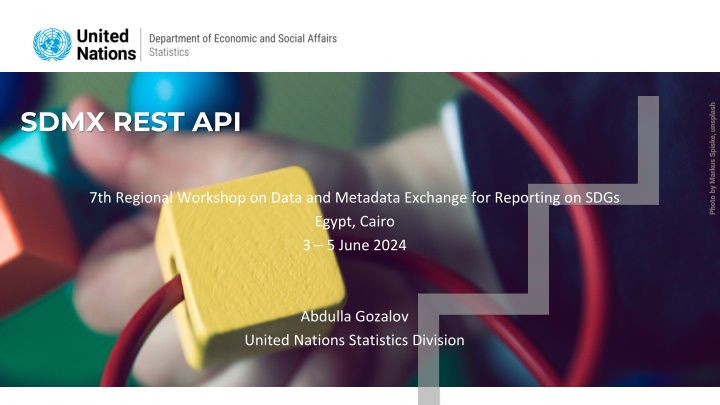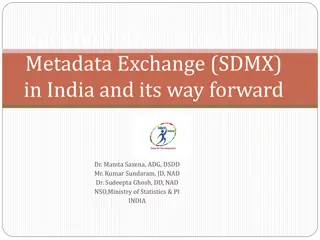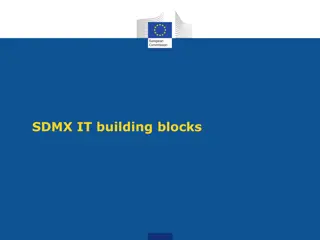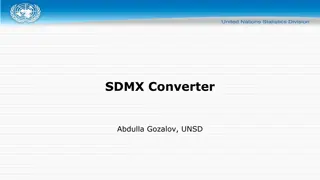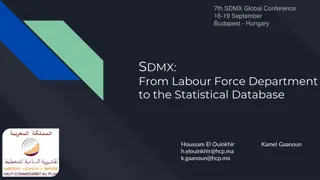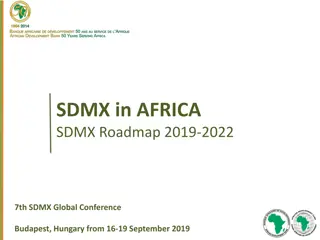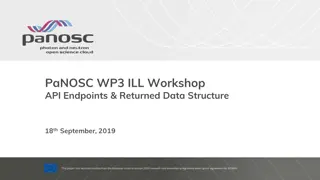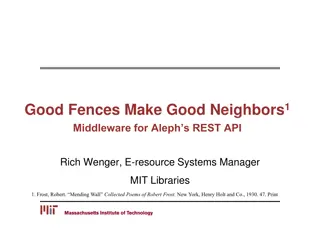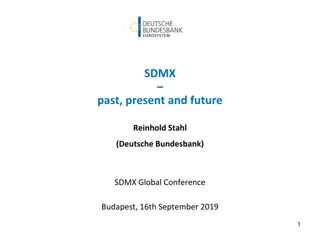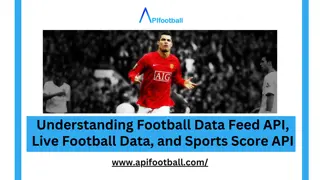SDMX REST API
SDMX REST API plays a crucial role in structuring and querying data for reporting on Sustainable Development Goals. This content provides insights into the use of URLs for queries, accessing structural metadata, and examples of querying datastructures and code lists. It highlights the transition from SOAP API to REST API and the importance of versioning and query parameters in retrieving relevant data. Explore how SDMX REST API facilitates data exchange and metadata retrieval in the context of statistical reporting.
Download Presentation

Please find below an Image/Link to download the presentation.
The content on the website is provided AS IS for your information and personal use only. It may not be sold, licensed, or shared on other websites without obtaining consent from the author.If you encounter any issues during the download, it is possible that the publisher has removed the file from their server.
You are allowed to download the files provided on this website for personal or commercial use, subject to the condition that they are used lawfully. All files are the property of their respective owners.
The content on the website is provided AS IS for your information and personal use only. It may not be sold, licensed, or shared on other websites without obtaining consent from the author.
E N D
Presentation Transcript
Photo by Markus Spiske, unsplash SDMX REST API 7th Regional Workshop on Data and Metadata Exchange for Reporting on SDGs Egypt, Cairo 3 5 June 2024 Abdulla Gozalov United Nations Statistics Division
SDMX Application Programming Interface (API) Originally based on the Simple Object Access Protocol (SOAP) SOAP API was discontinued in SDMX 3.0 Representational State Transfer (REST) API introduced from 2012 Latest REST API v2.0.0 Widely used REST API v1.5.0 Statistics Division 2
SDMX REST API Uses a URL to encompass a query https://data.un.org/ws/rest/codelist/IAEG-SDGs/CL_AREA Supports queries for structural metadata (DSD, dataflow, etc) and data Statistics Division 3
Structural metadata query http(s)://ws-entry-point/resource/agencyID/resourceID/version/itemID?queryStringParameters ws-entry-point: Root URL of the web service. resource: artefact type to be retrieved datastructure, dataflow, conceptscheme, codelist, categoryscheme, agencyID: Maintenance agency ID of artefact(s) to be retrieved resourceID: ID of artefact to be retrieved. version: Version of artefact to be retrieved. itemID: ID of the item to be retrieved, e.g. concept, code queryStringParameters: additional request parameters Statistics Division 4
Structural metadata query (2) Keyword all can be used to skip the parameter and return all agencies, resources, etc. This is the default if a parameter is omitted. Keyword latest can be used to return the last available version. This is the default if version is omitted. Query string parameters: detail: to control the level of detail returned. The default is full. references: to control related artefacts to be returned. Default is none, i.e. only the requested artefact is returned. You can also use children to add all artefacts referenced by the requested artefact; descendants to add children, their own children, and so on; parents to add all artefacts that reference the requested artefact; all to return both parents and descendants, and others. Statistics Division 5
Structural metadata query: examples https://data.un.org/ws/rest/codelist/IAEG-SDGs/CL_AREA Returns the latest version of the CL_AREA code list maintained by IAEG-SDGs. https://data.un.org/ws/rest/datastructure/IAEG-SDGs/SDG/latest/?references=all Returns the latest SDG DSD, agency scheme, dataflows, concept scheme, and code lists. Statistics Division 6
Data query http(s)://ws-entry-point/resource/flowRef/key/providerRef?queryStringParameters resource: Either data or metadata flowRef: Dataflow reference in the form of agencyID,dataflowID,version key: series to be retrieved. Dimensions are separated by a dot (.) All dimensions must be covered, but filter on a dimension can be omitted ( wildcarded ) Dimension values can be combined using the plus sign (+), equivalent to an OR operator providerRef: Data provider queryStringParameters: additional parameters Statistics Division 7
Data query: query string parameters startPeriod: Start period (inclusive). endPeriod: End period (inclusive) updatedAfter: Earliest time the data was updated. firstNoObservations: Maximum number of observations starting from the first observation. lastNObservations: Maximum number of observations counting back from the most recent observation. dimensionAtObservation: ID of the dimension attached at the observation level. Most often, TIME_PERIOD is used for time series representation. detail: full, dataonly, serieskeysonly, nodata includeHistory: Whether to return vintages Statistics Division 8
Data query: example Global Harmonized SDG dataflow https://data.un.org/ws/rest/data/IAEG-SDGs,DF_SDG_GLH, /...818+231+360.........../?detail=full&dimensionAtObservation=TIME_PERIOD Dataflow: IAEG-SDGs,DF_SDG_GLH, latest version of the DF_SDG_GLH dataflow. Note the version is omitted in the query. Series key: ...818+231+360........... return data for REF_AREA s Egypt, Ethiopia, and Indonesia. Note the order of dimension is significant. Data provider: omitted Detail: full dataset to be returned dimensionAtObservation=TIME_PERIOD for time series representation Statistics Division 9
HTTP Headers HTTP Headers are used for content negotiation If-Modified-Since Get the data only if something has changed Accept format of data to be returned Accept-Encoding compress the response The format of data and metadata to be returned can also be controlled through query string parameters, if supported, as defined in extended API. Statistics Division 10
Controlling the format of data and metadata through query string https://data.un.org/ws/rest/data/IAEG-SDGs,DF_SDG_GLH,/...818.........../?detail=full&dimensionAtObservation=TIME_PERIOD&format=csv Get Egypt s harmonized SDG dataset in the SDMX-CSV format. In data queries, commonly used formats include: structurespecificdata SDMX 2.1 Structure Specific XML format jsondata SDMX-JSON csv SDMX-CSV Statistics Division 11
Useful links SDMX REST API Repository https://github.com/sdmx-twg/sdmx-rest SDMX REST API Cheat Sheet (latest) https://github.com/sdmx-twg/sdmx-rest/blob/master/doc/rest_cheat_sheet.pdf SDMX REST API Cheat Sheet v1.5.0 https://github.com/sdmx-twg/sdmx- rest/blob/095d5356c727cd5da554a78b678650dad4b8c388/doc/rest_cheat_sheet.pdf Statistics Division 12
THANK YOU! Statistics Division 13
